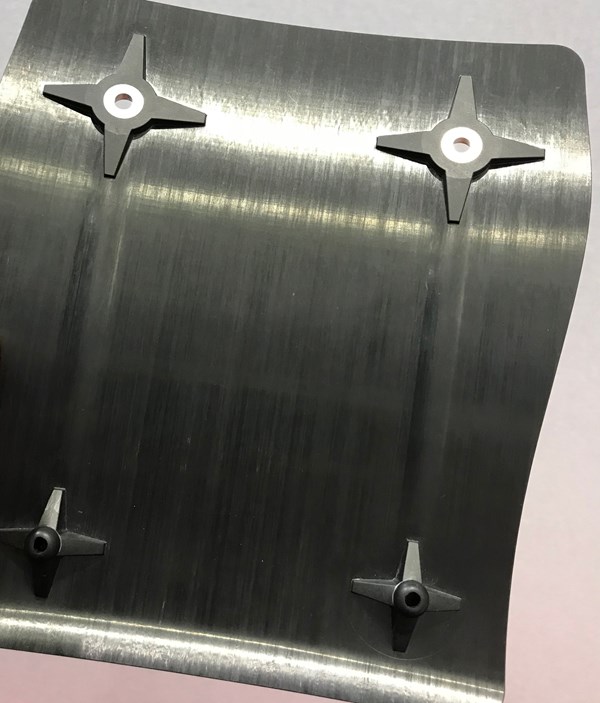So, you want to overmold
If so, CompositesWorld is hosting, June 13-14, the Composites Overmolding conference, to explore the software, materials and processes being used to combine continuous fiber composites with overmolded thermoplastics.

Tri-Mack Plastics (Bristol, RI, US) uses this demonstrator part to show how it can combine continuous fiber composite structures with injection overmolding. CW’s Composites Overmolding conference June 13-14 will explore materials and processes for this fast-evolving process.
For most of their histories, composites fabrication and thermoplastic injection molding have lived in their own worlds, linked by a common polymer DNA, but separated by process differences that have effectively cleaved these two industries.
Injection molding is highly automated, machine-dependent, volume-driven and cycle time-focused. Part quality is derived primarily from good process control, verified by randomized inspection. Resins are almost exclusively thermoplastic and most of the time are unreinforced. Technological innovation in injection molding is incremental at best. Major end markets are automotive, medical, packaging, appliance and consumer-goods industries. Aerospace, marine and wind energy — mainstays of the composites industry — are rarely mentioned in the injection molding industry.
Conversely, in the world of composites, the landscape is dominated by nearly infinite variations of resins, fibers, fiber formats, tools and manufacturing processes. Hand work is not uncommon, and there is almost no dependence on machinery of the type familiar to the injection molding industry. Cycle times are measured in hours, or at best, minutes, not seconds. Quality for many parts is assured via 100% inspection, and quality via process control is nearly unheard of. The great variety of available materials and processes make composites highly susceptible to change and innovation. Aerospace, marine and wind energy dominate. Automotive composites, until recently, have been relegated to the likes of Corvette and Lamborghini.
These two disparate worlds are now starting to come together. A fast-emerging process combines the endless potentialities of continuous fiber reinforcement with the mature and established injection molding process. Overmolding enables the fabrication of selectively reinforced parts. Continuous fiber preforms are placed strategically in a mold cavity and then are overmolded, partially or completely, by unfilled or chopped fiber-reinforced thermoplastic. This process is appealing for several reasons, but primarily because it offers molders the opportunity to produce structural parts with engineered reinforcement only where needed and produce those parts at unprecedented high rates. The result is a high-quality, but much more economical, process and part, which is good not just for the automotive sector, but the aerospace industry and other end markets as well. And overmolding is not limited to injection either. Overmolding via compression processes also is possible.
It is for these reasons that CW is proudly hosting the Composites Overmolding conference, June 13-14, in Novi, MI, US. For a day and a half CW will offer speakers and presentations that will explore the companies, materials and processes that are shaping overmolding today. The slate of presenters will include representatives from Ford Motor Co., Fraunhofer, PolyOne, SABIC, SGL, Victrex, KraussMaffei, Arburg, RocTool and much more. We will discuss design, materials and equipment for composites overmolding, exploring real and potential applications and where this process might lead the industry.
I hope you can join us and I encourage you to visit the Composites Overmolding site for more information, including agenda, registration and lodging details.
Related Content
-
Thermoplastic composites welding advances for more sustainable airframes
Multiple demonstrators help various welding technologies approach TRL 6 in the quest for lighter weight, lower cost.
-
The potential for thermoplastic composite nacelles
Collins Aerospace draws on global team, decades of experience to demonstrate large, curved AFP and welded structures for the next generation of aircraft.
-
PEEK vs. PEKK vs. PAEK and continuous compression molding
Suppliers of thermoplastics and carbon fiber chime in regarding PEEK vs. PEKK, and now PAEK, as well as in-situ consolidation — the supply chain for thermoplastic tape composites continues to evolve.
















